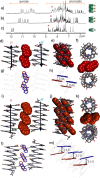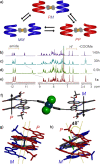Directing the Self-Assembly of Aromatic Foldamer Helices using Acridine Appendages and Metal Coordination
- PMID: 35965255
- PMCID: PMC9826129
- DOI: 10.1002/chem.202201345
Directing the Self-Assembly of Aromatic Foldamer Helices using Acridine Appendages and Metal Coordination
Abstract
Folded molecules provide complex interaction interfaces amenable to sophisticated self-assembly motifs. Because of their high conformational stability, aromatic foldamers constitute suitable candidates for the rational elaboration of self-assembled architectures. Several multiturn helical aromatic oligoamides have been synthesized that possess arrays of acridine appendages pointing in one or two directions. The acridine units were shown to direct self-assembly in the solid state via aromatic stacking leading to recurrent helix-helix association patterns under the form of discrete dimers or extended arrays. In the presence of Pd(II), metal coordination of the acridine units overwhelms other forces and generates new metal-mediated multihelical self-assemblies, including macrocycles. These observations demonstrate simple access to different types of foldamer-containing architectures, ranging from discrete objects to 1D and, by extension, 2D and 3D arrays.
Keywords: aromatic stacking; foldamer; helical conformation; metal coordination; self-assembly.
© 2022 The Authors. Chemistry - A European Journal published by Wiley-VCH GmbH.
Conflict of interest statement
The authors declare no conflict of interest.
Figures






Similar articles
-
Molecular Mechanism of Self-Assembly of Aromatic Oligoamides into Interlocked Double-Helix Foldamers.J Phys Chem B. 2017 Nov 2;121(43):10064-10072. doi: 10.1021/acs.jpcb.7b09067. Epub 2017 Oct 24. J Phys Chem B. 2017. PMID: 29019673
-
[Novel Helical Foldamers Based on the Conformational Properties of Aromatic Amides].Yakugaku Zasshi. 2019;139(4):581-589. doi: 10.1248/yakushi.18-00179-1. Yakugaku Zasshi. 2019. PMID: 30930393 Review. Japanese.
-
Aromatic Foldamer Helices as α-Helix Extended Surface Mimetics.Chemistry. 2020 Dec 23;26(72):17366-17370. doi: 10.1002/chem.202004064. Epub 2020 Nov 30. Chemistry. 2020. PMID: 32910480 Free PMC article.
-
Controlling Dipole Orientation through Curvature: Aromatic Foldamer Bent β-Sheets and Helix-Sheet-Helix Architectures.J Am Chem Soc. 2017 Oct 18;139(41):14668-14675. doi: 10.1021/jacs.7b07961. Epub 2017 Oct 9. J Am Chem Soc. 2017. PMID: 28965410
-
Foldectures: 3D Molecular Architectures from Self-Assembly of Peptide Foldamers.Acc Chem Res. 2017 Apr 18;50(4):832-841. doi: 10.1021/acs.accounts.6b00545. Epub 2017 Feb 13. Acc Chem Res. 2017. PMID: 28191927 Review.
Cited by
-
ProtInteract: A deep learning framework for predicting protein-protein interactions.Comput Struct Biotechnol J. 2023 Jan 25;21:1324-1348. doi: 10.1016/j.csbj.2023.01.028. eCollection 2023. Comput Struct Biotechnol J. 2023. PMID: 36817951 Free PMC article.
References
MeSH terms
Substances
Grants and funding
LinkOut - more resources
Full Text Sources

